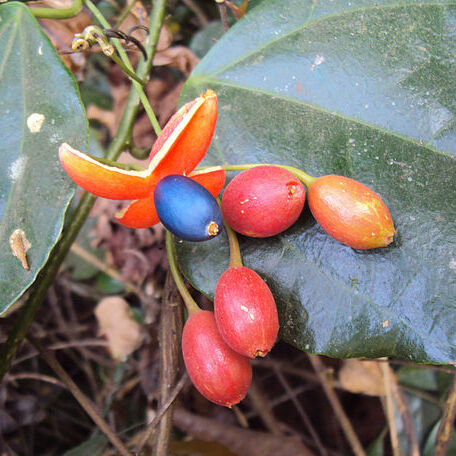Scandent shrub or liana, glabrous, 3-10 m; stem flexible; tendrils often lignescent-thickened distally, simple, or rarely bifid. Branches slender, elongate, sparingly rebranched, the free ends dropping; bark yellowish brownish, dotted with pale lenticels. Leaves variable in shape and size, triangularly ovate to ovate-or lanceolate-oblong, apex acuminate, tip acute, base broadly attenuate-truncate, rarely sub-cordate, mostly a little peltate, membranaceous to firmly chartaceous, rarely coriaceous, deep green above, glaucescent beneath when fresh, yellowish greenish in the dry state, fetid when bruised, (5-) 6-16 (-20,-25) by 6-12 (-15) cm; basal nerves 1 or 2 pairs, widely divergent and ascendent, 3-6 upper pairs spreading, prominent beneath, reticulations usually inconspicuous; petiole slightly thickened and wrinkled on both ends, (2-) 3-5 (-10) cm. Inflorescences peduncled, lax, very slender, repeatedly di-chotomous and many-flowered cymes, up to 15 cm long, these sometimes reduced to subsessile rather few-flowered cymes or fascicles; pedicels filiform, 4-5 mm; bracts triangular-ovate, hardly 1 mm. Calyx cupular, 5-toothed, 1 (-1.5) mm. Petals 5, ovate-triangular, glabrous, 1.5-2 mm. Stamens with a tuft of hairs on either side; filaments very short; anthers ovate-cordate, c. 0.3 mm; connective thick. Disk pentagonous, rather flat, fleshy, crenulate, 1.5 mm ø, elevated in the centre to form the short conical style with 3 small stigmas. Drupe pendulous, subglobose to ellipsoid or obovoid-pyriform, stipitate-at-tenuate towards the base for 2-3 cm, crowned by the persistent calyx lobes and the remains of the disk, 1.5-2 (-2.5) by 1.5-2.5 cm; pericarp thin-fleshy, yellow to red, rarely whitish; endocarp crustaceous; finally stellately splitting from top downwards into 3-6 reflexed segments, inside red. Seed indigo blue, evil smelling.
More
Lianas, 5-10 m tall, glabrous. Branchlets with ± persistent acute bud scales at base, with axillary tendrils. Petiole 3-10 cm; leaf blade ovate, oblong-ovate, or triangular-ovate, 8-20 × 4-15 cm, papery to ± leathery, base obtuse, truncate, or ± cordate, and usually peltate, apex acuminate; basal veins 3 or 5, abaxi-ally prominent, adaxially impressed. Cymes 6-18 cm, many-flowered; peduncle 4-10 cm. Pedicel filiform, 2-5 mm. Calyx cupular, 5-dentate, ca. 1 mm. Petals white, 1.5-2 mm. Stamens with tufts of hairs on either side. Disk elevated. Drupe ellipsoid to obovoid, 1.5-2.5 × 0.8-1.2 cm, crowned by persistent calyx; dehisced segments eventually recurving to display bright red inner surface. Seeds indigo blue, broadly ellipsoid. Fl. and fr. Mar-Sep.
A much branched climber. It grows 5-10 m high. The leaves are alternate and nearly triangular. They have a wavy edge. They are dark green on the upper surface and have a waxy bloom underneath. They are 9-16 cm long by 6-11.5 cm wide. The leaf stalk is swollen at the ends. It is 3-10 cm long. It has tendrils in the axils of leaves. The flower arrangements are 10 cm wide. The flowers are green with a yellow disk. The fruit is pear shaped. It is 1.5-1.8 cm long by 1 cm wide. It is yellow or red. It has a strong smell. There is one seed inside. This is oval and 1.2 cm long.


